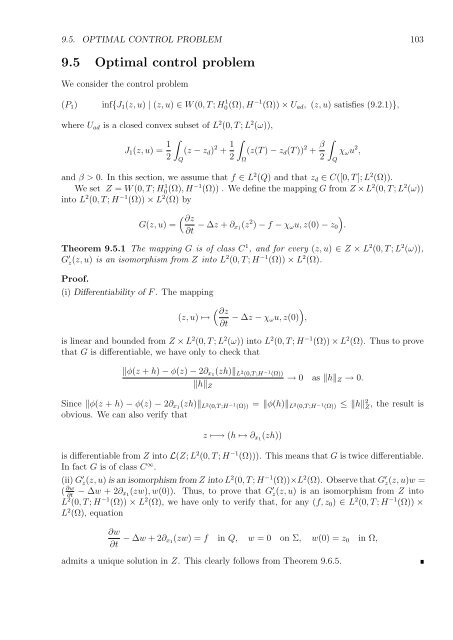Optimal Control of Partial Differential Equations
Optimal Control of Partial Differential Equations
Optimal Control of Partial Differential Equations
You also want an ePaper? Increase the reach of your titles
YUMPU automatically turns print PDFs into web optimized ePapers that Google loves.
9.5. OPTIMAL CONTROL PROBLEM 103<br />
9.5 <strong>Optimal</strong> control problem<br />
We consider the control problem<br />
(P1) inf{J1(z, u) | (z, u) ∈ W (0, T ; H 1 0(Ω), H −1 (Ω)) × Uad, (z, u) satisfies (9.2.1)},<br />
where Uad is a closed convex subset <strong>of</strong> L 2 (0, T ; L 2 (ω)),<br />
J1(z, u) = 1<br />
<br />
(z − zd)<br />
2 Q<br />
2 + 1<br />
<br />
(z(T ) − zd(T ))<br />
2 Ω<br />
2 + β<br />
<br />
χωu<br />
2 Q<br />
2 ,<br />
and β > 0. In this section, we assume that f ∈ L 2 (Q) and that zd ∈ C([0, T ]; L 2 (Ω)).<br />
We set Z = W (0, T ; H 1 0(Ω), H −1 (Ω)) . We define the mapping G from Z × L 2 (0, T ; L 2 (ω))<br />
into L 2 (0, T ; H −1 (Ω)) × L 2 (Ω) by<br />
G(z, u) =<br />
<br />
∂z<br />
∂t − ∆z + ∂x1(z 2 <br />
) − f − χωu, z(0) − z0 .<br />
Theorem 9.5.1 The mapping G is <strong>of</strong> class C 1 , and for every (z, u) ∈ Z × L 2 (0, T ; L 2 (ω)),<br />
G ′ z(z, u) is an isomorphism from Z into L 2 (0, T ; H −1 (Ω)) × L 2 (Ω).<br />
Pro<strong>of</strong>.<br />
(i) Differentiability <strong>of</strong> F . The mapping<br />
(z, u) ↦→<br />
<br />
∂z<br />
∂t − ∆z − χωu,<br />
<br />
z(0) ,<br />
is linear and bounded from Z × L 2 (0, T ; L 2 (ω)) into L 2 (0, T ; H −1 (Ω)) × L 2 (Ω). Thus to prove<br />
that G is differentiable, we have only to check that<br />
φ(z + h) − φ(z) − 2∂x1(zh) L 2 (0,T ;H −1 (Ω))<br />
hZ<br />
→ 0 as hZ → 0.<br />
Since φ(z + h) − φ(z) − 2∂x1(zh)L 2 (0,T ;H−1 (Ω)) = φ(h)L2 (0,T ;H−1 (Ω)) ≤ h2 Z , the result is<br />
obvious. We can also verify that<br />
z ↦−→ (h ↦→ ∂x1(zh))<br />
is differentiable from Z into L(Z; L 2 (0, T ; H −1 (Ω))). This means that G is twice differentiable.<br />
In fact G is <strong>of</strong> class C ∞ .<br />
(ii) G ′ z(z, u) is an isomorphism from Z into L 2 (0, T ; H −1 (Ω))×L 2 (Ω). Observe that G ′ z(z, u)w =<br />
( ∂w<br />
∂t − ∆w + 2∂x1(zw), w(0)). Thus, to prove that G ′ z(z, u) is an isomorphism from Z into<br />
L 2 (0, T ; H −1 (Ω)) × L 2 (Ω), we have only to verify that, for any (f, z0) ∈ L 2 (0, T ; H −1 (Ω)) ×<br />
L 2 (Ω), equation<br />
∂w<br />
∂t − ∆w + 2∂x1(zw) = f in Q, w = 0 on Σ, w(0) = z0 in Ω,<br />
admits a unique solution in Z. This clearly follows from Theorem 9.6.5.

















